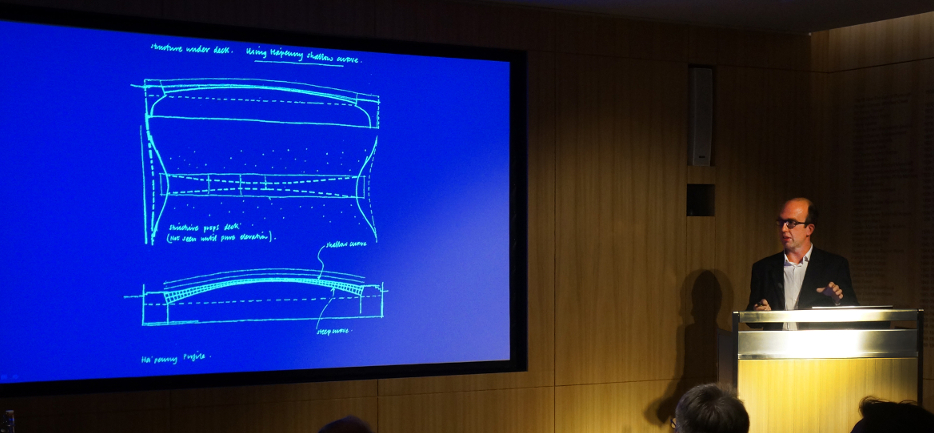[pullquote align=”]’Gentleman, we have run out of money; now we have to think'[/pullquote]
This Churchill quote has come to Tim Lucas’ mind often throughout his career at Price & Myers. Fortunately, Tim has an apparent innate ability to deliver projects for his clients that could perhaps initially have been thought to be over ambitious ideas.
It is this ability that has helped him win the 2015 IASBE British Group Milne Medal, a medal which is awarded to an individual engineer for excellence in structural design, both in the overall concept and in the attention to detail in their work. During the 19th November’s IABSE Milne Medal lecture at the Institution of Structural Engineer’s headquarters in Bastwick Street, Tim had no problems demonstrating to the audience why he is thoroughly deserving of the prize.

From early in his career, Tim has embraced digital technologies in order to turn ideas into reality. Unbelievably Tim was using 3D AutoCAD as far back as 1997 to design the competition winning Dublin Millennium portal framed footbridge. How else could he deal with the complicated torus inspired curves of the bridge’s haunched supports? The design also innovated by having solid rather than hollow chords to achieve the structure’s desired slender aesthetic.
This was but the first of over 15 projects presented to the audience from Tim’s impressive portfolio of work ranging from simple and elegant building and bridges to large and small works of art. It is surely his expertise in approach to the fantastic design opportunities presented to him that has made him a lecturer in Structural Design at the Bartlett School of Architecture and a Partner at Price & Myers.
His skill, digital craftsmanship and his immense knowledge of the “art of making” enables him to make complex structural shapes and concepts. He particularly enjoys the challenge of going back to first principles to make use of the shell as structure. One analogy used by Tim is that virtually every motor vehicle used up to the 1930s used to have the same chassis but with different shells on top. Since then vehicles have been made with purpose built unibody construction to make them much more efficient. Why can’t the material used to clad a structure be used as part of the structure?
He tries to take inspiration from this for his designs. Take the fantastic Meads Reach footbridge over Bristol’s floating harbour. The structure has a stainless steel stressed skin. Laser cut perforations in this skin reveal the inner ribbed structure at night when the bridge is internally illuminated. Ingeniously, the perforations are distributed to be less dense in highly stressed regions both presenting an efficient design and a structure that demonstrates how it is working. Of course, the perforation was distributed with a self-written computer code.
He believes that the industry provides a fantastic kit of parts that can be used for new and novel ways. He has used this idea to create public realm art by taking things that are not structural and making them structural. He describes the Chair for Arching in High Wycombe as a “Joyfully cartwheeling structurally sound set of chairs”. The arch made of chairs has been used as a climbing frame by his two girls who were in the audience.
In similar vein, the practise’s popular Hy-Pavilion which was designed for the London Festival of Architecture, formed of intersecting hyperbolic paraboloids made from straight line timber beams and bungee ropes, delights wherever it goes and cost only £7k to build. Tim claims that the clever folding mechanism that allows it to be easily transported and erected was a fortunate accident of the idea.
Manufacture is central to Tim’s thinking. He has developed new and better ways to precision engineer employing techniques such as laser cutting, CNC routing and water jetting. Tim believes one of the key benefits is being able to derisk information allowing both clients to take the leap of faith and for the design to be buildable to the regular craftsman.

Though Tim concedes that quality makers are essential to the process. He relied on many for his 2015 RIBA House of the Year Shortlisted home in Kew which was aired on the Grand Designs special only a week prior to the lecture. With the structure being formed of perfectly fitting prefabricated modular Corten steel shells, there was over 6 months of on-site welding for one heavily in credit welder. Tim is genuinely pleased that his work has been able to show the public how craftsmanship and technology combined can be used to great benefit.
The challenging designs that Tim faces on a seemingly day to day basis require significant thought investment, skill and care to realise the ideas of his clients. However, Tim has used technology to be able to design intelligently, continually using the newest in making technologies to be able to produce designs that his clients are able to fund and are not be able to forget. Certainly not when they receive their annual laser cut Price & Myers Christmas cards!
An excellent three course dinner at St Bart’s Brewery followed.
Ed Dablin, IABSE British Group Executive Committee Member and Senior Engineer at Tony Gee & Partners.

